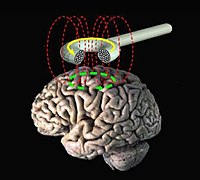
Photo from wikipedia
We assessed corticomotor excitability in the primary motor cortex (M1) of participants with moderate-to-severe restless legs syndrome (RLS) symptoms using transcranial magnetic stimulation (TMS) in relation to the clinical and… Click to show full abstract
We assessed corticomotor excitability in the primary motor cortex (M1) of participants with moderate-to-severe restless legs syndrome (RLS) symptoms using transcranial magnetic stimulation (TMS) in relation to the clinical and sleep aspects of the disease. Thirty-five participants (20 F; mean age: 59.23 ± 1.66 years; range: 42-78 years) affected by primary RLS (off medications) and 31 age-matched controls (19 F; mean age: 57.90 ± 1.50 years; range: 43-79 years) underwent TMS following two nights of polysomnography (PSG). Paired-pulse TMS measures [short-interval intracortical inhibition (SICI), long-interval intracortical inhibition (LICI), and intracortical facilitation (ICF)] of the dominant M1hand and M1leg muscles were collected and analyzed in relation to clinical features of RLS and PSG. We found decreased corticomotor excitability in M1hand, whereas it was increased in M1leg, which was greater in patients with more severe RLS. Participants with RLS with a history of dopamine-agonist-induced symptom augmentation showed decreased LICI (reduced inhibition) compared to nonaugmented participants with RLS for M1leg. None of the TMS measures (M1hand or M1leg) correlated with the PSG parameters. This study shows hyperexcitability in M1leg, and this appears related to RLS disease severity and decreased excitability in M1hand. The results provide new insight into the complex neurobiology of RLS, particularly in more advanced stages of the disease.
Journal Title: Sleep medicine
Year Published: 2018
Link to full text (if available)
Share on Social Media: Sign Up to like & get
recommendations!